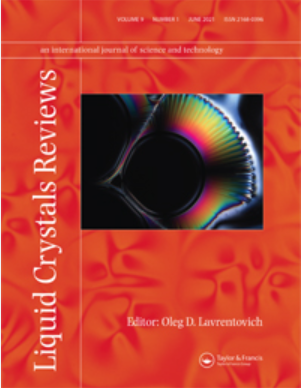Single-photon experiments with liquid crystals for quantum science and quantum engineering applications
IF 4.2
3区 材料科学
Q2 CHEMISTRY, PHYSICAL
引用次数: 10
Abstract
We present here our results on using liquid crystals (LCs) in experiments with nonclassical light sources: (1) single-photon sources exhibiting antibunching (separation of all photons in time), which are key components for secure quantum communication systems and (2) entangled photon source with photons exhibiting quantum interference in a Hong–Ou–Mandel interferometer. In the first part, both nematic and cholesteric liquid crystal (CLC) hosts were used to create definite linear or circular polarization of antibunched photons emitted by different types of single emitters (dye molecules, nanocrystal quantum dots (NQDs), nanodiamonds with color centers, etc.). If the photon has unknown polarization, filtering it through a polarizer to produce the desired polarization for quantum key distribution with bits based on polarization states of photons will reduce by half the efficiency of a quantum cryptography system. In the first part, we also provide our results on observation of a circular polarized microcavity resonance in NQD fluorescence in a 1-D chiral photonic bandgap CLC microcavity. In the second part of this paper with indistinguishable, time-entangled photons, we demonstrate our experimental results on simulating quantum mechanical barrier tunneling phenomena. A Hong–Ou–Mandel dip (quantum interference effect) is shifted when a phase change was introduced on the way of one of entangled photons in pair (one arm of the interferometer) by inserting in this arm an electrically controlled planar-aligned nematic LC layer between two prisms in the conditions close to a frustrated total internal reflection. By applying different AC-voltages to the planar-aligned nematic layer and changing its refractive index, we can obtain various conditions for incident photon propagation – from total reflection to total transmission. Measuring changes of tunneling times of photon through this structure with femtosecond resolution permitted us to answer some unresolved questions in quantum mechanical barrier tunneling phenomena.液晶单光子实验在量子科学和量子工程中的应用
本文介绍了我们在非经典光源实验中使用液晶(lc)的结果:(1)单光子源表现出反聚束(所有光子在时间上的分离),这是安全量子通信系统的关键组件;(2)在Hong-Ou-Mandel干涉仪中表现出量子干涉的光子纠缠光子源。在第一部分中,向列相和胆甾相液晶(CLC)宿主被用于创建由不同类型的单发射器(染料分子、纳米晶体量子点(NQDs)、具有色心的纳米钻石等)发射的反束光子的明确的线性或圆偏振。如果光子具有未知的偏振,则将其通过偏振器过滤以产生基于光子偏振态的量子密钥分配所需的偏振,这将使量子密码系统的效率降低一半。在第一部分中,我们还提供了我们在一维手性光子带隙CLC微腔中观察NQD荧光的圆偏振微腔共振的结果。在本文的第二部分,我们用不可区分的时间纠缠光子,展示了我们模拟量子力学势垒隧穿现象的实验结果。在接近失谐全内反射的条件下,在一对纠缠光子(干涉仪的一条臂)的其中一条臂中插入一个可控制的平面向列LC层,在这条臂中引入相位变化,从而改变了hong - u - mandel dip(量子干涉效应)。通过对平面向列层施加不同的交流电压并改变其折射率,我们可以得到入射光子从全反射到全透射的各种传输条件。用飞秒分辨率测量光子通过该结构的隧穿时间的变化,使我们能够回答量子力学势垒隧穿现象中一些尚未解决的问题。
本文章由计算机程序翻译,如有差异,请以英文原文为准。
求助全文
约1分钟内获得全文
求助全文
来源期刊

Liquid Crystals Reviews
CHEMISTRY, PHYSICALCRYSTALLOGRAPHY&n-CRYSTALLOGRAPHY
CiteScore
7.60
自引率
5.90%
发文量
8
期刊介绍:
Liquid Crystals Reviews publishes review articles on all aspects of liquid crystal fundamentals and applied science, including experimental and theoretical studies of physical and chemical properties, molecular design and synthesis and engineering of liquid crystal devices. The Journal fosters cross-disciplinary exchange of ideas, encouraging authors to present material at a level accessible to specialists from other fields of science and engineering. Liquid Crystals Reviews provides the scientific community, in both academia and industry, with a publication of standing, guaranteed by the Editors and by the International Editorial Board who are active scientists in the worldwide liquid crystal community.
 求助内容:
求助内容: 应助结果提醒方式:
应助结果提醒方式:


